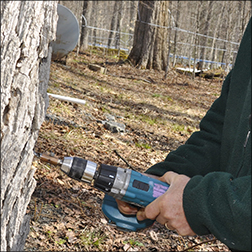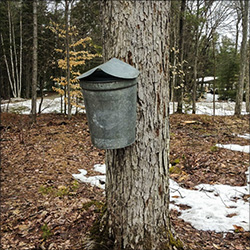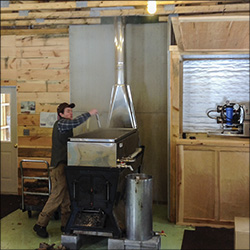Maple Sugaring at the VIC
The VIC Sugar Bush
 Maple sugaring at the Paul Smiths VIC: VIC Sugar Bush. Photo by Tom Boothe.
Maple sugaring at the Paul Smiths VIC: VIC Sugar Bush. Photo by Tom Boothe. Maple syrup is among the oldest natural food products produced in North America. Maple sap was first collected and processed by the indigenous peoples of North America. The practice was adopted by European settlers, who gradually refined production methods.
Maple syrup is currently produced in the northeastern regions of the US and Canada. In the US, Vermont is the largest producer (1.3 million gallons in 2013), followed by New York State (.6 million gallons). New York State currently taps less than 1% of the state's nearly 300 million maple trees.
Maple syrup is among the oldest natural food products produced in North America. Maple sap was first collected and processed by the indigenous peoples of North America. The practice was adopted by European settlers, who gradually refined production methods.
Maple syrup is currently produced in the northeastern regions of the US and Canada. In the US, Vermont is the largest producer (1.3 million gallons in 2013), followed by New York State (.6 million gallons). New York State currently taps less than 1% of the state's nearly 300 million maple trees.
The VIC's Maple Sugaring Program is part of a larger effort to increase local maple syrup production in New York State as a path to sustainable economic development. To that end, the VIC has developed two demonstration sugar bushes – one with lines and one with buckets – to model what a family could do in their own back yard. The sugar bushes are located near the intersection of the Skidder Trail and the Easy Street Trail. The tubing is on the left hand side of the Skidder Trail (proceeding west); the buckets are concentrated on the other side of the Skidder Trail from the tubing, but are also dispersed in places where there are groups of suitable maples. About 130 Sugar Maples (Acer saccharum) were tapped for the 2013 sugaring season. Sugar Maples are generally chosen for sugaring operations, because the sap of these trees has a higher sugar content than that of other maples.
 Sugaring season in our part of the Adirondack Mountains usually lasts around five or six weeks, beginning as the weather warms in March.
Sugaring season in our part of the Adirondack Mountains usually lasts around five or six weeks, beginning as the weather warms in March.
- Early in the spring, when the maple trees are still dormant, temperatures rise above freezing during the day. As a result, positive pressure develops in the tree, causing the sap to flow out of the tree through a half-inch wide tap hole which has been drilled about 4.5 feet above the ground.
- When the temperature drops back below freezing at night, suction develops, drawing water into the tree through the roots and replenishing the sap in the tree. This allows the sap to flow again during the next warm period.
- This cycle of warm and cool periods is essential for sap flow.
The sugar content of sap from maple trees varies depending on the health of the tree and the time of the season:
- Sugar content is lowest at the beginning of the season (when the tree is shaking off its winter dormancy) and the end of the season (as the tree depletes its starch reserves.)
- At the height of the season, when the tree’s warmed up and is efficiently converting starch to sugar, the sugar content in a mature tree should be up around 2.5 percent.
- Trees also vary in sugar content from year to year.
 The sap is collected from the trees and transported to the VIC Sugar House for processing. The VIC's maple sugaring operation uses a wood-fired evaporator to remove the water from sap to produce syrup. The Sugar House was built during the fall of 2013, by VIC staff, along with volunteers and Paul Smith's College students. The majority of the lumber was harvested from the VIC grounds, and some was milled on site by students using the college saw mill. The wood used to fuel the evaporator is harvested by students and staff from the VIC property and stored behind the sugar house. The VIC is currently developing interpretive signage for the Sugar House to help visitors understand and appreciate sugar making. Maple products produced in the VIC Sugar House are sold at the VIC store.
The sap is collected from the trees and transported to the VIC Sugar House for processing. The VIC's maple sugaring operation uses a wood-fired evaporator to remove the water from sap to produce syrup. The Sugar House was built during the fall of 2013, by VIC staff, along with volunteers and Paul Smith's College students. The majority of the lumber was harvested from the VIC grounds, and some was milled on site by students using the college saw mill. The wood used to fuel the evaporator is harvested by students and staff from the VIC property and stored behind the sugar house. The VIC is currently developing interpretive signage for the Sugar House to help visitors understand and appreciate sugar making. Maple products produced in the VIC Sugar House are sold at the VIC store.
